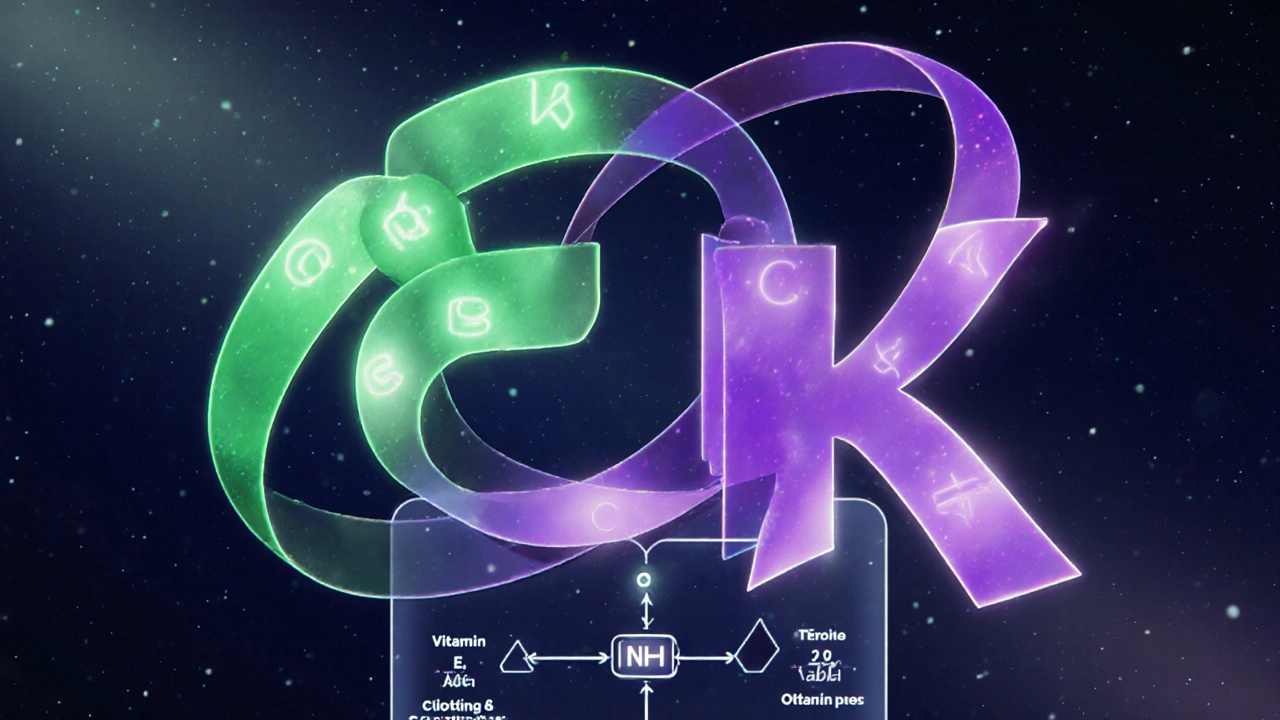Vitamin Interaction Checker
Check Your Supplement Combos
Select the vitamins and minerals you're taking to see potential interactions and get timing recommendations.
Select supplements to check for potential interactions...
Key Takeaways
- Certain fat‑soluble vitamins compete for the same absorption pathways.
- Minerals like calcium and iron can block each other when taken at the same time.
- Timing (morning vs. evening) and taking supplements with food matter a lot.
- Separate problematic pairs by at least 2-4 hours, or take one with a meal and the other on an empty stomach.
- Use a simple weekly schedule to keep your regimen safe and effective.
Why vitamin interactions matter
When you pop a multivitamin or a handful of single‑nutrient pills, you expect each one to do its job. In reality, many vitamins and minerals share transport proteins, enzymes, or intestinal receptors. If two nutrients vie for the same slot, the one that arrives later often gets bundled out, lowering its bioavailability. Over time, this can create hidden deficiencies or excesses, both of which may trigger fatigue, digestive upset, or more serious health concerns.

Common antagonistic pairs
Below are the most frequently cited “don't mix” combos, backed by clinical studies and nutrition‑science reviews up to 2024.
- Vitamin A a fat‑soluble vitamin that supports vision, immune health, and cell growth & Vitamin D a fat‑soluble vitamin that regulates calcium and bone metabolism
- Vitamin E an antioxidant that protects cell membranes from oxidative damage & Vitamin K a fat‑soluble vitamin essential for blood clotting and bone health
- Calcium a mineral vital for bone strength, nerve signaling, and muscle contraction & Iron a mineral needed for hemoglobin formation and oxygen transport
- Zinc a trace mineral involved in immune function, DNA synthesis, and wound healing & Copper a trace mineral that works with iron and supports connective tissue
- Magnesium a mineral that regulates muscle function, blood pressure, and energy production & Vitamin B6 a water‑soluble vitamin crucial for amino‑acid metabolism
Deep dive into high‑risk combos
Vitamin A vs. Vitamin D
Both are fat‑soluble, stored in the liver, and rely on the same carrier proteins (retinol‑binding protein for A and vitamin‑D‑binding protein for D). Taking large doses together can saturate those carriers, leaving one vitamin under‑absorbed. The risk is most evident in high‑dose therapeutic regimens rather than standard multivitamins.
Practical tip: If you need both, separate them by at least 3 hours or take one with a meal rich in healthy fats and the other on an empty stomach.
Vitamin E vs. Vitamin K
Vitamin E’s antioxidant action can inhibit the enzyme gamma‑carboxylase, which activates Vitamin K‑dependent clotting factors. This antagonism matters for people on anticoagulant therapy (e.g., warfarin) but can also slightly prolong bleeding time in healthy individuals when both are taken in high doses.
Recommendation: Keep supplement doses below 400 IU for Vitamin E if you’re also using Vitamin K supplements, and space them out by 2-4 hours.
Calcium & Iron
Calcium competes with iron for the divalent metal transporter (DMT1) in the duodenum. Studies show that a 250mg calcium dose can reduce iron absorption by up to 50% when taken together.
Best practice: Take iron supplements with vitamin C on an empty stomach, and schedule calcium (or calcium‑rich foods) at a different meal or before bedtime.
Zinc & Copper
Zinc induces the production of metallothionein, a protein that binds copper and prevents its absorption. Long‑term high‑zinc supplementation (>40mg/day) can cause copper deficiency, leading to anemia and neutropenia.
Solution: If you need both, keep zinc under 30mg and take copper at least 2 hours apart, preferably with a meal.
Magnesium & Vitamin B6
Vitamin B6 (pyridoxine) increases renal excretion of magnesium. Taking them together in large amounts may blunt magnesium’s calming effect on nerves and muscles.
Advice: Separate high‑dose B6 (often used for PMS) from magnesium supplements, or use a balanced B‑complex that contains moderate B6.
How to schedule your supplements
Creating a simple timing plan removes most conflicts. Below is a sample routine that works for most adults with a balanced diet.
- Morning (with breakfast): Fat‑soluble vitamins A, D, E, K - take them together with a healthy fat source (e.g., avocado, nuts).
- Mid‑morning (30min after breakfast): Water‑soluble B‑complex and Vitamin C - they absorb best on an empty stomach.
- Midday (with lunch): Calcium - pair with dairy or leafy greens; avoid iron at this time.
- Afternoon (around 3pm): Iron supplement with a glass of orange juice (vitaminC boosts absorption). Skip calcium.
- Evening (dinner): Magnesium - helps relax muscles before sleep. If you’re also taking zinc, place zinc with dinner and keep copper for bedtime.
- Before bed: Copper (if needed) - low‑dose copper gluconate works well overnight.
Adjust the timing if you experience stomach upset; some people prefer taking B‑vitamins with food to reduce nausea.
Quick reference table of problematic pairings
| Pair | Why they clash | Recommended timing |
|---|---|---|
| Vitamin A & Vitamin D | Compete for same fat‑soluble carrier proteins | Separate by 3hours or take one with meals, other on empty stomach |
| Vitamin E & Vitamin K | Vitamin E can inhibit Vitamin K‑dependent clotting factors | Space by 2-4hours; keep Vitamin E < 400IU if co‑taken |
| Calcium & Iron | Calcium blocks iron’s DMT1 transporter | Take iron with Vitamin C on empty stomach; calcium at another meal |
| Zinc & Copper | Zinc induces metallothionein, binding copper | Zinc < 30mg; copper at least 2hours apart, preferably with food |
| Magnesium & Vitamin B6 | High B6 raises renal magnesium loss | Take high‑dose B6 in the morning; magnesium in the evening |

Tips to avoid hidden conflicts
- Read supplement labels carefully - many multivitamins already contain balanced ratios.
- Don’t assume “natural” means “safe”; herbal extracts can also affect mineral absorption.
- Consult a healthcare professional before combining high-dose supplements, especially if you take prescription meds.
- Track your intake using a simple spreadsheet or a nutrition app that flags overlapping nutrients.
- Stay hydrated - water helps dissolve water‑soluble vitamins and prevents GI irritation.
Frequently Asked Questions
Can I take a multivitamin with individual supplements?
Yes, but only if the total dose of each nutrient stays within the Recommended Dietary Allowance (RDA). Double‑checking the label prevents accidental overdoses, especially for fat‑soluble vitamins.
Do I need to separate supplements on an empty stomach?
Water‑soluble vitamins (B‑complex, C) absorb best on an empty stomach, while fat‑soluble vitamins need dietary fat. Separate them based on these rules, not necessarily every hour.
Is it safe to take calcium at bedtime?
Many people find bedtime calcium supports bone repair during sleep, and it doesn’t interfere with iron or most other minerals if taken a few hours after dinner.
What if I forget a dose?
Skip the missed dose and resume your regular schedule. Doubling up can create the very interactions you’re trying to avoid.
Are there any foods that mimic these interactions?
Yes. For example, eating dairy (high in calcium) alongside iron‑rich meals can lower iron absorption, just like the supplement combo. Balancing meals the same way you balance pills works well.
By understanding which vitamins and minerals fight for the same absorption slots, you can plan a safe, effective supplement routine. A little timing adjustment goes a long way toward keeping your body fully nourished.



